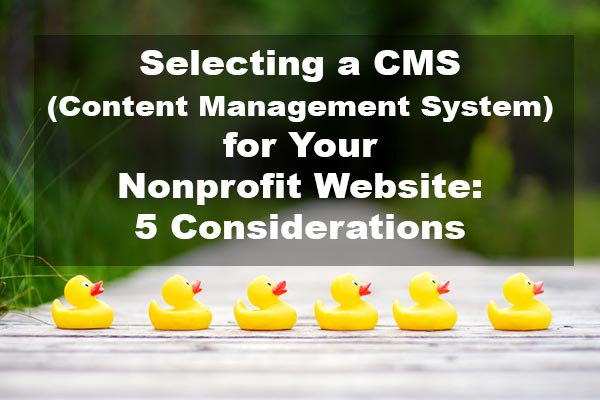As a nonprofit, much of your focus revolves around fundraising. After all, you can’t successfully run your programs and work toward your mission without sufficient funds.
Your nonprofit website is a key component in this process. Without an effective fundraising website, you won’t bring in nearly as many donations as you could.
Choosing the right content management system (CMS) for your website is an essential step to ensure you create the most impactful way for donors to easily give to your organization. Below are five considerations to take into account as you choose a CMS for your nonprofit website:
1. Select a CMS with an Intuitive Interface
The first, and arguably the most important, consideration when choosing your CMS is that it’s designed with nonprofits in mind. Most of your nonprofit staff is likely non-technical with little to no coding experience, which means your CMS should accommodate that.
Look for CMS features such as:
- Drag-and-drop editing. Drag-and-drop editors allow your staff to pick from a set of pre-designed elements so you can easily experiment with your page layout. Create a clean, crisp look using simple tools so your visitors can easily navigate through your website.
- Live editing tools. If you use a CMS with live editing tools, you’ll be able to edit your pages on the front-end and view exactly how they will look in real-time.
- Social media integrations. After your website, social media is one of the most popular ways supporters will engage with your nonprofit. Leverage embedded live feeds to drive traffic from your website to your social media accounts. Your chosen CMS should offer this integration capability.
- Configurable donation forms. Your CMS should offer intuitive donation form building tools so you can get up and running with collecting donations. Offer suggested giving amounts, recurring gift options, and edit the form fields so you can make the most of your donation page.
If you want to maintain a clean website and keep donors engaged, make sure your interface is easy to navigate and that your staff can create an attractive design without coding knowledge. From there, you’ll be able to keep your website updated with announcements and news that your supporters can easily find and view, as well as collect donations.
Also read: Why Your Nonprofit Should Use Pinterest and Instagram
2. Select a CMS That Offers Mobile Functionality
These days, most individuals view websites on their mobile devices. Whether they’re researching an organization or filling out a form, it’s safe to say that many potential and current supporters will access your website via a mobile device.
This means that your CMS should offer mobile-responsive features. This applies to:
- Your webpages
- Your online forms within the pages
- Your overall look and design
- Your images and videos
- A “call us” link that automatically initiates a call on the user’s device
Your CMS can make optimizing all of these elements for mobile simple. Responsive websites adjust the structure of the page to accommodate the user’s screen size. The information should be presented in an easy-to-read manner regardless of the user’s screen size. Whether you’re looking at images or forms, they should be presented in an appealing manner.
This especially applies to your forms. Your forms include:
- Donation forms
- Volunteer sign-up forms
- Event registration forms
- And more
If users are attempting to fill out one of these forms on their mobile device and they have to zoom in to view the fields or rotate their screens, they have a higher chance of abandoning the form. Think about all the donations you could miss out on if donors abandon the donation form due to poor user experience.
Be sure your entire website is optimized for mobile so you don’t miss out on opportunities to engage your supporters, collect donations, and make your organization stand out.
3. Select a CMS with SEO Tools
In order to boost awareness around your organization, your website needs to be easy to find via search engines. This is where search engine optimization (SEO) comes into play. SEO is the process of making your website searchable online.
When a user types the name of your organization or related terms into Google, your website will ideally populate in the search results. Your CMS should offer the following tools to help make this happen:
- Meta title editors. Your meta title is the title that search engines display when users come across your website in the search results. Your CMS should make it easy to edit your meta title so you can boost click-through rates and drive more traffic to your website.
- Custom meta descriptions. A meta description tells users what your page is about. This gives them a better idea of the content and whether your page will offer the information they’re seeking. Your CMS should allow you to easily edit your meta descriptions.
- Targeted keywords. Leverage a CMS that allows you to edit the text on your page to include important keywords so that search engines know what your pages are about. This can help boost your page rankings.
- Custom URLs. Shorter URLs that include your target keyword(s) are more effective in helping your page rank on search engine results. Your CMS should allow you to choose a custom URL so you can reach the right people online and boost your click-through rate.
Leveraging these SEO tools will help increase your website’s visibility online. Be sure to use a CMS that makes it easy to incorporate SEO elements into your website so you can find more visitors and boost engagement with your organization.
Also read: Charity Navigator vs. CharityWatch: What Your Nonprofit Needs to Know
4. Select a CMS with Add-On Modules
When it comes to customizing your website, your nonprofit should keep some other tools in mind that not all CMS platforms may have. Donors sometimes prefer to give in other ways aside from donating money, so be sure your CMS offers add-on modules. These can include:
- eCommerce. Adding an online store to your nonprofit’s website is a great way to add another revenue stream. Your CMS should offer digital storefront functionality so you can sell items like custom shirts and other branded merchandise, event tickets, and more.
- Event management tools. Your CMS should make it easy to streamline your event management process. Easily design event registration pages and update supporters on your events calendar to keep them engaged.
- Private pages. Password-protected pages allow your organization to offer members-only content, online forums, file sharing, and more. Choose a CMS that allows you to manage user access for specific content like pages and blogs.
By choosing a CMS with these simple add-on modules, you’ll be able to add a level of customization to your site that helps boost your revenue and increase attendance at events. Your site should be customized to exactly what your organization needs, so make sure your CMS accommodates that. More features to look for in a CMS platform.
5. Select a CMS That Offers Good Customer Support
Another consideration you should take into account when choosing a CMS is their support team. Your CMS should be geared toward organizational growth, which means the platform should continue to accommodate your needs over time.
Consider these factors as you search for the right CMS:
- Flexible pricing model. If your nonprofit is just starting out, you may not want to spend a lot of money on a CMS upfront. Pick a platform that offers scaled pricing packages so you can keep using the same platform as your organization grows and your needs evolve.
- Web design consultation. You’re likely to have questions while building your website, and even after it’s up and running. Choose a CMS that offers consultation services and can steer you in the right direction.
- Reliable customer support. There’s a chance you may encounter technical issues, so it’s important to choose a CMS that offers ongoing support services for any issues that may come up.
Good customer support is a top consideration for CMS platforms because it can impact the final result: your website’s effectiveness. Be sure to choose a CMS that allows you to not only create an impactful website but also maintain it and scale it as you grow.
As you begin your buyer’s journey and explore the CMS options available to you, be sure to choose one that is designed with nonprofits in mind. It should be easy to modify your pages, boost visibility via SEO tools, and offer your supporters a positive user experience as they discover what your organization is all about.
About the author:
Murad Bushnaq is the Founder and CEO of Morweb. Since its inception in 2014, Murad has acted as Creative Director and Chief Technologist to help nonprofits spread their vision online through engaging design, intuitive software, and strategic communication.


